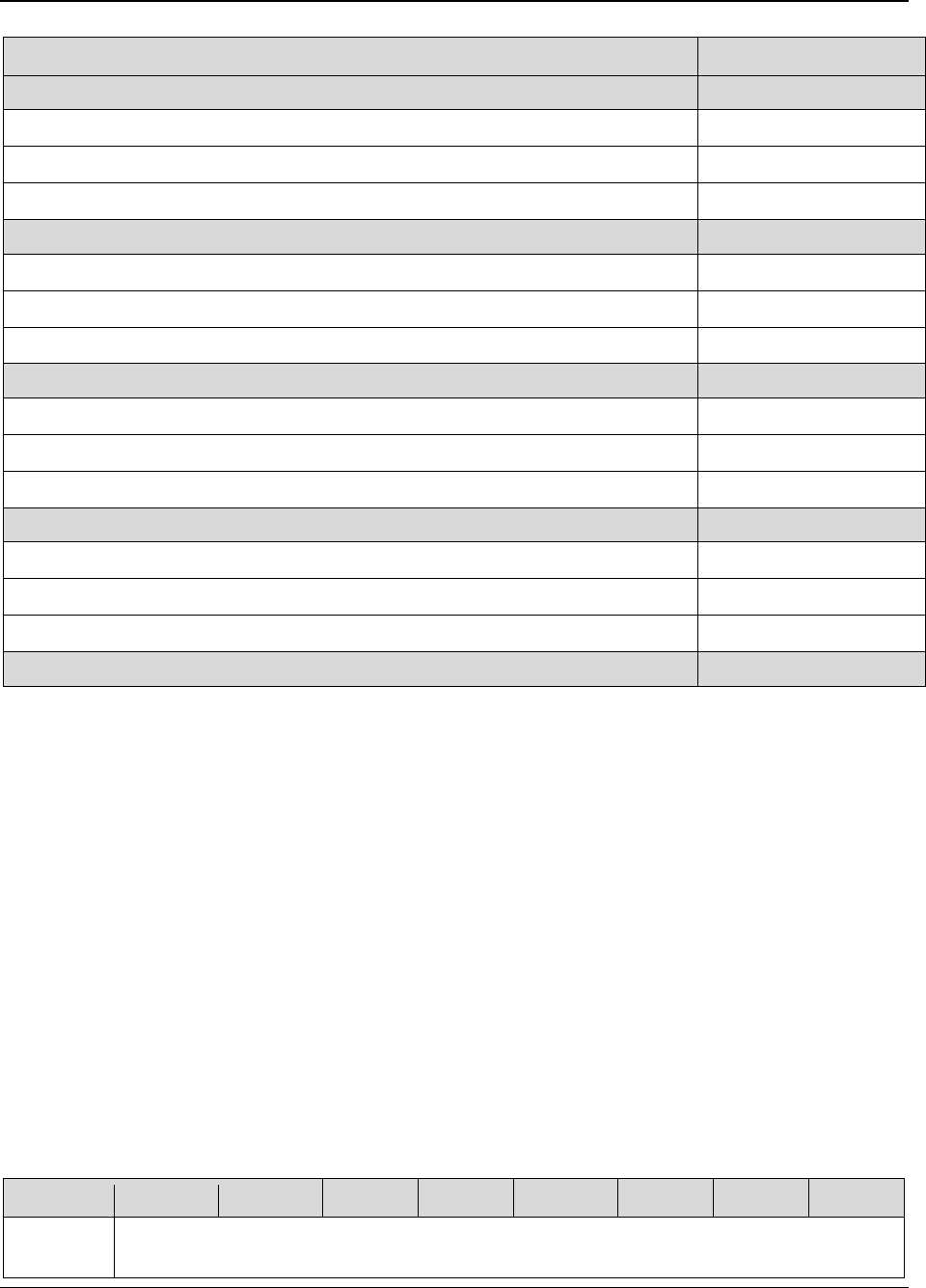Programmer's99875629 Owner's manual
Table Of Contents
- Table of Contents
- 1 Introduction
- 2 Connection Types
- 3 Command Set
- 3.1 About Big Block Data Mode
- 3.2 About SRED / Non-SRED Firmware
- 3.3 About Commands Tagged As “MAC”
- 3.4 General Feature Reports
- 3.4.1 Report 0x01 – Response ACK
- 3.4.2 Report 0x02 – End Session
- 3.4.3 Report 0x03 – Request Swipe Card
- 3.4.4 Report 0x04 – Request PIN Entry
- 3.4.5 Report 0x05 – Cancel Command
- 3.4.6 Report 0x06 – Request User Selection
- 3.4.7 Report 0x07 – Display Message
- 3.4.8 Report 0x08 – Request Device Status
- 3.4.9 Report 0x09 – Set Device Configuration
- 3.4.10 Report 0x09 – Get Device Configuration
- 3.4.11 Report 0x0A – Request MSR Data
- 3.4.12 Report 0x0B – Get Challenge
- 3.4.13 Report 0x0D – Send Session Data - Amount
- 3.4.14 Report 0x0D – Send Session Data - PAN
- 3.4.15 Report 0x0E – Get Information
- 3.4.16 Report 0x0F – Login/Authenticate
- 3.4.17 Report 0x0F – Logout
- 3.4.18 Report 0x10 – Send Big Block Data to Device
- 3.4.19 Report 0x11 – Request Manual Card Entry
- 3.4.20 Report 0x14 – Request User Data Entry
- 3.4.21 Report 0x1A – Request Device Information
- 3.4.22 Report 0x1C – Set/Get BLE Power Configuration (BLE Only)
- 3.4.23 Report 0x1D – Set BLE Module Control Data (BLE Only)
- 3.4.24 Report 0x1E – Set iAP Protocol Info (30-pin Only)
- 3.4.25 Report 0x1E – Get iAP Protocol Info (30-pin Only)
- 3.4.26 Report 0x1F – Request Clear Text User Data Entry
- 3.4.27 Report 0x30 – Set / Get KSN
- 3.4.28 Report 0x31 – Set KSN Encrypted Data
- 3.4.29 Report 0x32 – Set BIN Table Data (MAC)
- 3.4.30 Report 0x32 – Get BIN Table Data
- 3.4.31 Report 0xFF – Device Reset
- 3.5 General Input Reports
- 3.5.1 Report 0x20 – Device State Report
- 3.5.2 Report 0x21 – User Data Entry Response Report
- 3.5.3 Report 0x22 – Card Status Report
- 3.5.4 Report 0x23 – Card Data Report
- 3.5.5 Report 0x24 – PIN Response Report
- 3.5.6 Report 0x25 – User Selection Response Report
- 3.5.7 Report 0x27 – Display Message Done Report
- 3.5.8 Report 0x29 – Send Big Block Data to Host
- 3.5.9 Report 0x2A – Delayed Response ACK
- 3.5.10 Report 0x2B – Test Response
- 3.5.11 Report 0x2D –BLE Module Control Data (BLE Only)
- 3.5.12 Report 0x2E – Clear Text User Data Entry Response Report
- 3.6 EMV-Related Reports
- 3.6.1 Report 0x2C – EMV Cardholder Interaction Status Report
- 3.6.2 Report 0xA1 – Set or Get EMV Tag(s) (MAC)
- 3.6.3 Report 0xA2 – Request Start EMV Transaction
- 3.6.4 Report 0xA4 – Acquirer Response (MAC)
- 3.6.5 Report 0xA5 – Set or Get CA Public Key (MAC)
- 3.6.6 Report 0xA8 – Get Kernel Info
- 3.6.7 Report 0xAB – Request EMV Transaction Data (MAC)
- 3.6.8 Report 0xAC – Merchant Bypass PIN Command
- Appendix A Examples
- Appendix B Terminology
- Appendix C Status and Message Table
- Appendix D MagTek Custom EMV Tags
- Appendix E Configurations
- Appendix F Error Codes
- Appendix G User-Defined Messages
- Appendix H Factory Defaults
- Appendix I Language and Country Codes
- Appendix J BLE Module Control Data
- J.1 BLE Module Configuration Properties
- J.1.1 Get property command
- J.1.2 Set property command
- J.1.3 Software ID property
- J.1.4 Bluetooth Device Address property
- J.1.5 Bluetooth Device Name property
- J.1.6 Configuration Revision property
- J.1.7 Power Timeout property
- J.1.8 Power Control property
- J.1.9 Advertising Control property
- J.1.10 Passkey property
- J.1.11 Desired Minimum Connection Interval Property
- J.1.12 Desired Maximum Connection Interval Property
- J.1.13 Desired Slave Latency Property
- J.1.14 Desired Supervision Timeout Property
- J.1.15 Connection Parameter Update Request Control Property
- J.2 Other Commands
- J.1 BLE Module Configuration Properties

2 - Connection Types
DynaPro Mini| PIN Encryption Device | Programmer’s Reference (Commands)
Page 20
Item
Value (Hex)
Report ID (0xAA) - Set
85 AA
Usage (Confirm Session Key)
09 AA
Report Count (17)
95 11
Feature (Data,Var,Abs,NWrp,Lin,Pref,Nnul,Buf)
B2 02 01
Report ID (0xAB) - Set
85 AB
Usage (Request EMV Transaction Data)
09 AB
Report Count (4)
95 04
Feature (Data,Var,Abs,NWrp,Lin,Pref,Nnul,Buf)
B2 02 01
Report ID (0xAC) - Set
85 AC
Usage (Merchant Bypass PIN Command)
09 AC
Report Count (1)
95 01
Feature (Data,Var,Abs,NWrp,Lin,Pref,Nnul,Nvol,Buf)
B2 02 01
Report ID (0xFF) - Set
85 FF
Usage (Device Reset)
09 1E
Report Count (02)
95 02
Input (Data,Var,Abs,NWrp,Lin,Pref,Nnul,Buf)
B2 02 01
End Collection
C0
2.2 How to Use Apple iOS UART Connections
When DynaPro Mini is connected to an iOS host via the Apple 30-pin dock connector, custom apps use
iPod Accessory Protocol (iAP1) to communicate with DynaPro Mini using the EASession class. The
custom software wraps commands in simple Get/Set wrappers, also called a UART packet header. The
device firmware expects to receive and send data using the same formats produced by the iAP
iPodDataTransfer and AccessoryDataTransfer commands, respectively. Documentation for
these formats is available from Apple, specifically in MFi Accessory Firmware Specification R44 (see
http://developer.apple.com/programs/mfi/). Sample code is available in the form of Apple’s EADemo
app; see https://developer.apple.com/library/IOS/samplecode/EADemo/Introduction/Intro.html.
Because the command set is common to all connection types, it is also helpful to read section 2.1.1 About
HID Usages to become familiar with the types of available commands.
The devices only use TXD and RXD; hardware handshaking is not available. The serial settings are
57600 bps, No parity, 8 data bits, and 1 stop bit. Code upgrade commands are not available through
this connection. To communicate with a device using the UART connection, the host should begin all
commands and responses with the following UART packet header:
Table 2-2 - iOS UART Packet Header
Bit
7
6
5
4
3
2
1
0
Byte 0
0x00 = Get
0x01 = Set










